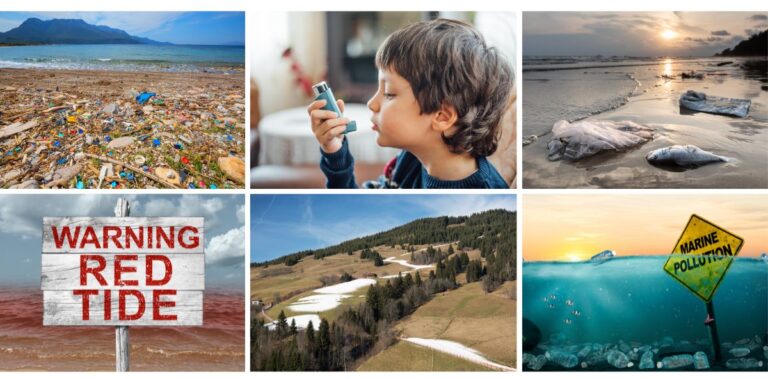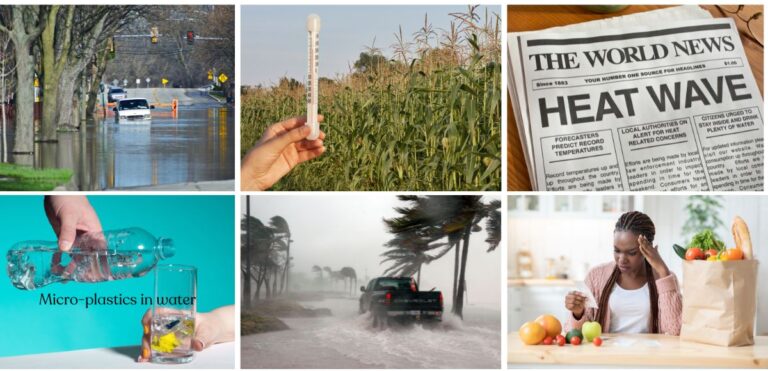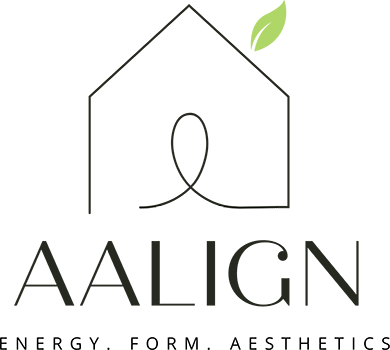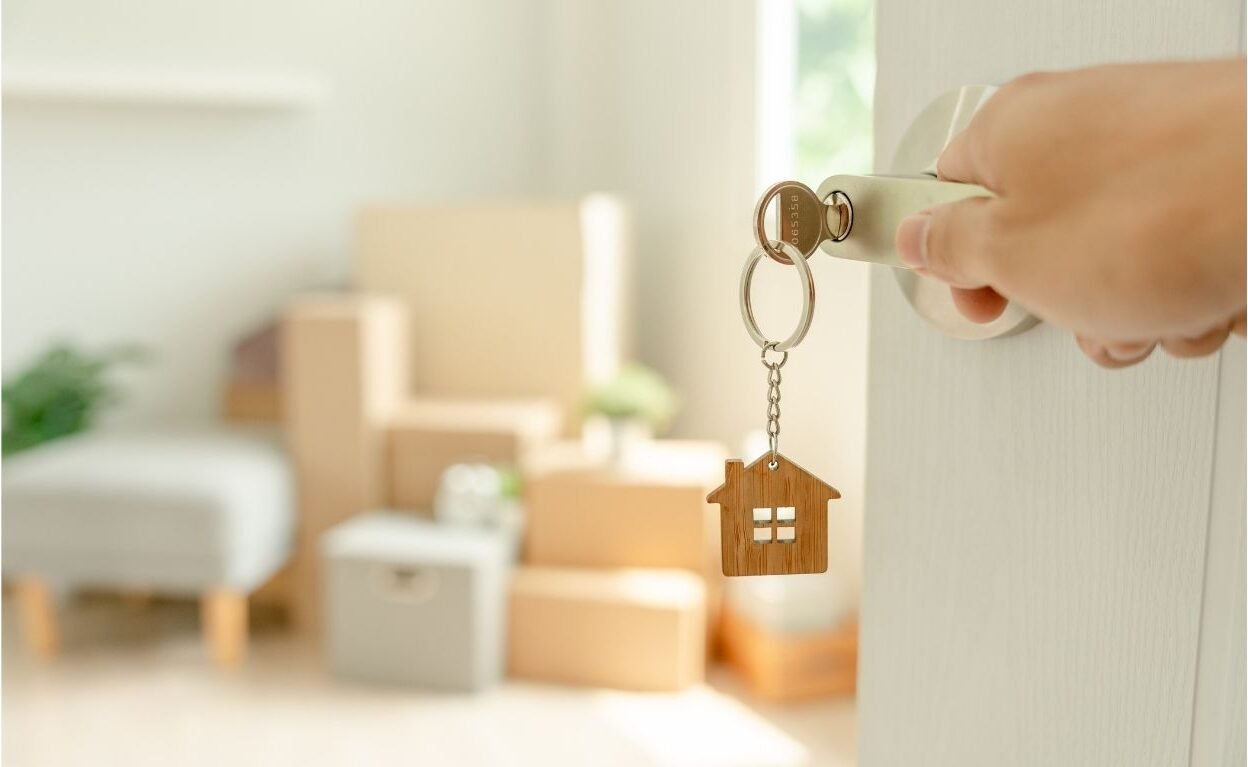"Our Buildings & Homes Should Be Nurtured By Nature And Rise With Pride!"
- Amara Naqvi Tweet
The Unseen Ways An Unhealthy Environment Causes Problem For Us

To get a clear perspective, let’s take a closer look at how an unhealthy environment resulting from climate change, water contamination, soil degradation, and air pollution affects our daily lives.
Ever experienced the frustration of excessive seaweed or red tide ruining a beach day? The reason is that warm water temperatures create ideal conditions for algae, specifically phytoplankton, to thrive. Additionally, the presence of excessive nutrients in water runoff from agriculture and untreated sewage fuels these harmful algal blooms (causing rapid and excessive growth of algae and phytoplankton). Nutrient runoff acts as fertilizer for these algae, causing them to grow exponentially. As this massive algal bloom dies, it consumes a significant amount of oxygen in the water, blocks sunlight from reaching underwater plants, and can produce toxins. This entire process harms fish and disrupts aquatic ecosystems. In addition to these blooms, oil spills and other harmful bacteria also contribute to more frequent beach closures.
- How about traveling somewhere and encountering unexpected and unbearable heat that took away from the experience?
- Consider when your favorite seafood item was unavailable. Plastic pollution and ocean acidification are responsible for the shortage of safe seafood in recent years. Also, prices of seafood are higher due to scarcity and decline in marine life.
- Concerns about contaminants in fish, like mercury and PCBs, have led to increased advisories against consuming certain fish species. This makes seafood safety a growing concern, especially for pregnant women, young children, and people who frequently eat fish. (Example: Advisories against consuming certain fish species in the Great Lakes).
- What about our soaring grocery bills? Droughts and heatwaves reduce crop yields and lead to crop failures. Even more frustrating is the fact that those who prefer their fruits and vegetables natural (organic) and free of pesticides, herbicides, hormones, and harmful GMOs must now pay more.
- How about the taste of produce, besides paying higher prices? Chemical pollutants are affecting the taste of produce in many areas due to deteriorating soil quality. Deficiencies in nutrients or contaminated soil affect the flavor, aroma, and overall quality of fruits and vegetables that we once took for granted.
- Water contamination? Increasing numbers of incidents of chemicals being found in drinking water supply are causing people to become ill (examples: lead contamination in Flint, Michigan, algal blooms in Lake Erie).
- How about the frustration of watching our loved ones suffer from worsening allergies or respiratory conditions during intense pollen seasons? Respiratory problems and lung diseases are continuously on the rise due to environmental pollution, including vehicle emissions, factories, power plants, and various other sources. As a result of climate change, blooming seasons are starting earlier, and pollen seasons are extending. Unusually warm springs are leading to higher ragweed and pollen production, exacerbating allergy symptoms in both adults and children and making them more severe than usual.
- Consider how warmer winters have led to reduced snowfall and shorter ski seasons in multiple regions, negatively impacting local tourist economies, disappointing winter sports fans, and affecting enjoyable family ski trips during winter breaks. For instance, shorter ski seasons in the Alps highlight this trend.

- Have you noticed how rising temperatures and unpredictable weather patterns have disrupted outdoor activities, affecting not only athletes but also families and leisure pursuits. To avoid excessive heat and dehydration, people are reluctant to be outdoors, whether for work, events, or even during student sports practices.
For instance, severe heatwaves delayed Wimbledon 2023. California wildfires in 2020 closed hiking trails and national parks. Additionally, gardening and public pools were affected by water restrictions during the 2023 European summer.
- How about witnessing the loss of our planet’s natural beauty firsthand? From wildfires and melting glaciers to plastic waste choking our oceans and spoiling scenic coastlines, evidence is everywhere. Excessive construction and deforestation to meet modern needs further diminish our greenery, adding to this collective sense of guilt.
- Think about the higher electricity bills or the higher insurance premiums homeowners pay because natural disasters occur more frequently and more severely.
- What about the growing presence of microplastics in our water supply which is now a cause for concern? These tiny plastic fragments, originating from sources like synthetic clothing fibers, micro beads in cosmetics, and both regular and “forever” plastics, have been detected in tap and even bottled water globally, raising uncertainty about water safety. As a result, some consumers are now investing in water filtration systems and bottled water services to address this issue. It’s important to note, however, that bottled water isn’t guaranteed to be microplastic-free, and filter systems vary in their effectiveness.
- Microplastics have also been detected in seafood, raising concerns about the safety of consuming fish, shellfish, and particularly mussels. However, some research suggests that inhalation of microplastics might pose a greater risk than ingestion. These tiny plastic fibers, shed from clothing, carpeting, and furniture in our built environments, can be smaller than a human hair, making them easily inhaled.
- Diminishing Coral reefs! Rising ocean temperatures is also endangering coral reefs worldwide through a process known as bleaching, which turns them white and puts them at risk of disease and extinction. These vibrant ecosystems are vital for marine life, providing food and shelter, threatening biodiversity when disrupted. Furthermore, degraded coral reefs negatively impact tourism, affecting industries such as hotels, restaurants, and dive shops, as seen in instances like coral bleaching on Australia’s Great Barrier Reef.
- How about the human cost of climate change, which is vast and deeply concerning? Frequent floods, droughts, and rising sea levels displace people from their homes, causing immense stress and uncertainty. Coastal communities like Miami Beach, Florida, Venice, and Pacific island villages face rising sea levels and erosion, forcing relocations.
- Beyond displacement, property values in areas susceptible to environmental damage, particularly coastal regions, are already decreasing. This economic impact adds another layer of difficulty for those living in these areas.
- Consider the smallest things, such as the Christmas tree shortages last year that prevented many of us from purchasing a fresh tree. Temperatures rising and droughts in Christmas tree-growing regions led to shortages and higher Christmas tree prices in 2022.
The Unseen Ways Our Daily Actions Cause Problems For The Environment

Let’s pause for a moment and consider what small habits collectively pollute our soil, water, and air and further degrade our environment on a global scale:
- When we use single-use plastics daily (for example, straws, cutlery, water bottles, and plates), despite alternatives, it results in tremendous amount of plastic pollution, particularly in the ocean that harms marine life. Typical to-go coffee cups, for example, are made from paper with a plastic lining to prevent tearing or getting wet, making them non-recyclable and non-biodegradable.
Many buildings are excessively and carelessly over-cooled or over-heated. This wastes a large amount of energy, driving up the bills. But the consequences go beyond our wallets. Since sixty percent of U.S. electricity comes from fossil fuels, this wasted energy also pollutes our air and soil.
- When our car engine is left running in parking lots or school car lines, even in pleasant weather, harmful emissions such as carbon dioxide are unnecessarily released.
Leaving lights on in empty rooms causes a hidden energy drain. It not only increases electricity bills, but also contributes to CO2 emissions from power plants.
- Running the dishwasher half full, leaving the faucet running while brushing teeth, or allowing water to run during a long shower are examples of water waste. Not only does this deplete this precious resource, but also results in increased water bills.
- Paper use that is unnecessary or excessive contributes to deforestation and energy consumption as well.
- In spite of the fact that many items are still reusable, such as toys, books, building materials, gift wrapping, and unused school supplies, they are thrown away without hesitation. It’s time to reconsider what we discard, whether it’s functional electronics or perfectly usable furniture.
- The livestock farming industry contributes to greenhouse gas emissions, deforestation, and water pollution as a result of excessive meat consumption.
- Fast fashion choices, such as buying inexpensive clothes and dumping them, harm the environment. The textile industry uses petroleum-derived products, such as polyester (as well as nylon and acrylic), which emit significant amounts of carbon dioxide. Since 2000, clothing production has doubled, yet only a small portion is recycled.
Polyester fabric, for example, is produced using plastic.
- First, it contributes to greenhouse gas emissions.
- Second, polyester clothing releases micro-plastics into our precious water resources when washed.
***Micro-plastics can be captured by reverse osmosis and activated carbon filters, but these aren’t widely available. Given that washing fabrics made with plastics releases micro-plastics into the ocean, it is unclear why they have not yet been banned.
- The infinite use of chemical cleaners that contain volatile organic compounds (VOCs) results in air pollution, and when disposed of, these chemicals pollute rivers, lakes, and oceans and its natural ecosystems.
Food waste! The problem isn’t just about throwing away uneaten food; it’s about wasting precious resources throughout the entire food supply chain. Aside from food waste, there is also the loss of resources like water, energy, and land associated with growing, transporting, and preparing it. Methane gas is also released in landfills from discarded food contributing to global warming.
- Shopping online is convenient, but there is a hidden cost: greenhouse gas emissions. You might not realize how much of an impact online shopping has on the environment. Large cargo ships, delivery trucks, planes, excessive packaging, and return trips all contribute to these emissions. While a single phone case purchased online might seem insignificant, when multiplied by millions of online orders every day, the environmental impact becomes substantial.
- Frequently shopping online also leads to excessive packaging that wastes natural resources and overloads landfills with non-recyclable materials like plastics and paper.
- Watching movies and music streaming online seems harmless, but the data centers that power these services consume massive amounts of electricity from non-renewable sources.
The hidden cost of our electronics goes beyond the purchase price. Manufacturing them requires a hefty investment of resources. Mining the metals, destroying habitats, and using large amounts of energy (often from fossil fuels) all contribute to a significant environmental footprint.
Improper disposal only deepens this problem. Hazardous materials leach into the environment, polluting our soil, water, and air.
- We rely heavily on batteries for our everyday devices, often discarding them without a second thought. Even though disposable batteries are essential, their improper disposal raises environmental concerns. The lithium, cobalt, and nickel in these batteries are toxic to soil if they leak. The good news is, we can reduce this risk by switching to rechargeable batteries. This will reduce the over disposal problem, but also save money!
How to Address the Ongoing Issues?
Measures to reduce harmful algal blooms, seaweed growth, and red tides:
Get agriculture to stop using excessive amounts of fertilizers pesticides etc. If that’s not possible, at least filter their water before it runs off into ours. Enhance wastewater treatment to remove excess nutrients before water reaches rivers and oceans.
We need to call on the agriculture industry to reduce its excessive use of fertilizers and pesticides. If achieving this proves impossible, then implementing mandatory measures to filter their water before it flows into our water systems is essential. Enhancing wastewater treatment processes will remove excess nutrients before they reach rivers and oceans. Therefore, agriculture practices should be subjected to stricter regulations to reduce fertilizer usage and conserve soil.
Taking on climate change, one of the biggest issue
What can be done about global warming that is causing extreme weather that causes half of the problems mentioned above?
What the government should do: Ban single-use plastics, with specific exceptions for essential facilities such as hospitals, laboratories, etc.
What we should do: It’s our responsibility to hold businesses, venues, schools, arenas, stadiums, hotels, and restaurants accountable for their excessive waste generation and lack of consideration for the environment. We must make them aware of their responsibilities and the severity of their actions. They should feel the weight of their contribution to destroying our environment and therefore us, as if they were breaking an actual law. We need to demand they act responsibly.
To mitigate the problem, suggest alternatives such as biodegradable single-use items with recyclable plastic linings or biodegradable single-use items. Encouraging them to prioritize serving food and beverages in biodegradable options will help reduce their carbon footprint.
To combat ocean pollution and acidification, we must take decisive action:
1. Reduce plastic waste: Promote biodegradable alternatives and tighten up plastic regulations.
2. Control industrial pollution: Enforce tough rules on industrial waste disposal to prevent harmful pollutants from entering the ocean.
3. Limit carbon emissions: Take measures to reduce greenhouse gas emissions, thereby slowing down ocean acidification and mitigating its impact on marine ecosystems.
To address droughts, heatwaves, and rising food costs, we can take the following steps:
1. Water conservation: Promote water-saving practices in agriculture and individual use, and encourage the adoption of sustainable irrigation methods.
2. Support organic farming: Offer incentives for organic farming practices to enhance soil health and decrease dependency on chemical fertilizers, thereby promoting sustainable agriculture.
To address chemical pollutants and improve produce quality, we can implement the following measures:
1. Reduce pesticide use: Invest in research and development of alternative pest control methods to reduce reliance on chemical pesticides.
2. Organic options: Encourage organic farming practices to make healthy produce more accessible.
3. Renewable energy: Reduce air pollution from power plants by switching to renewable energy.
4. Urban planning: Support urban planning strategies that reduce car dependency and promote cleaner transportation options, which reduce air pollution.
To address the loss of natural beauty, we can take the following actions:
1. Forest conservation: Protect existing forests and encourage reforestation to restore damaged areas.
2. Reduce waste: To keep our oceans and landscapes beautiful, reduce plastic consumption and waste generation.
To tackle the issue of microplastics in water and food, we can undertake the following actions:
1. Microplastic reduction: Reduce microplastic pollution by reducing synthetic clothing fibers and single-use plastics at their source.
2. Improve wastewater treatment: Fix wastewater treatment facilities to capture and remove microplastics before they’re discharged.
3. Research and development: Invest in research and development to mitigate microplastic’s harmful effects on aquatic ecosystems and food sources by detecting and removing them.
To combat coral reef degradation, we can undertake the following actions:
1. Ocean acidification control: Address climate change, as it’s a primary driver of ocean acidification, which threatens coral reefs.
2. Coral restoration efforts: Support research and initiatives aimed at restoring and protecting coral reef ecosystems.
Point Of Alignment
When demand exists, supply follows!
As the global population increases and we persist in transforming green land into urban developments, it is crucial to rethink and adopt smarter approaches that do not ignore environmental consequences, because neglecting them could make our planet uninhabitable. We need a shift! By using methods that follow nature’s lead, we can create a future where our homes and buildings are healthy for both us and the planet.





